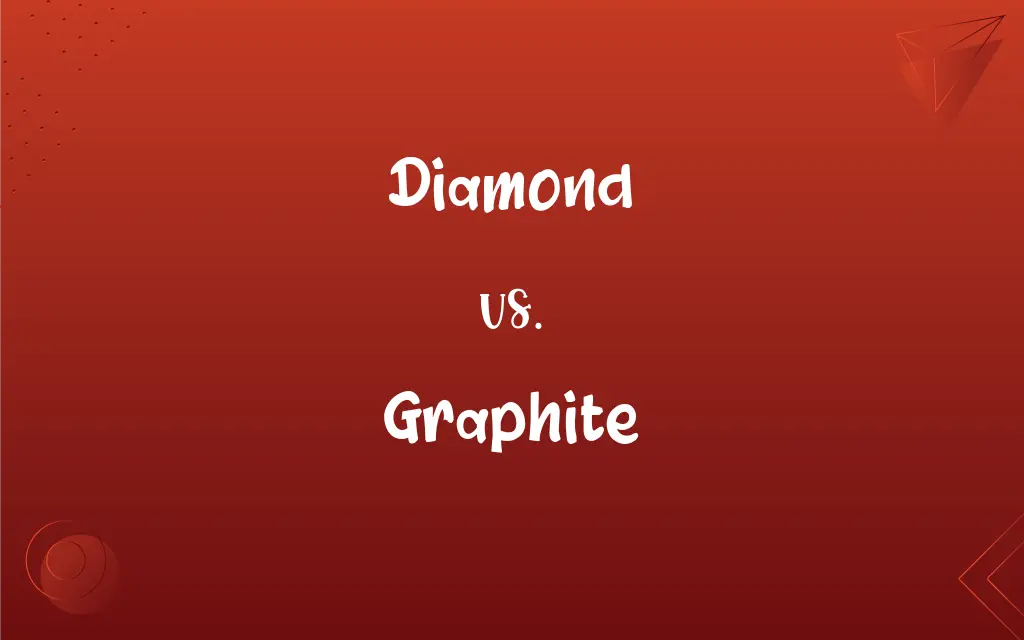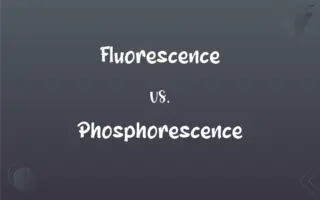Diamond vs. Graphite: What's the Difference?
Edited by Janet White || By Harlon Moss || Updated on October 21, 2023
Diamond and graphite are both forms of carbon; diamond has a tetrahedral structure making it hard, while graphite has layered hexagonal structures, making it soft and conductive.

Key Differences
Diamond is a naturally occurring allotrope of carbon known for its brilliance and hardness. Its carbon atoms are arranged in a tetrahedral lattice, giving it its characteristic strength. Conversely, graphite, another allotrope of carbon, possesses a hexagonal layered structure. This structural difference results in the layers of graphite easily sliding over each other, giving it its characteristic slippery feel.
From a physical property perspective, diamond is transparent and is the hardest known natural material. Its strength and refractive properties make it valuable in jewelry and industrial applications. Graphite, on the other hand, is opaque, black, and slippery. Its layered structure lends it a unique combination of being soft yet also highly conductive of electricity.
In terms of applications, diamond's hardness makes it invaluable for cutting, grinding, and drilling. Its optical properties also make it a gemstone of choice in jewelry. Graphite, with its excellent conductivity and lubricating properties, finds use in pencils, lubricants, and as an electrode in batteries.
Chemically, both diamond and graphite are resistant to many common chemicals due to the strength of the carbon-carbon bonds. However, their reactivity can differ under specific conditions. For example, diamond can burn in an oxygen-rich environment to produce carbon dioxide, while graphite can react with certain chemicals due to its exposed layered structure.
To encapsulate, while both diamond and graphite are forms of carbon, their distinct atomic structures lead to vastly different physical properties and applications. The tetrahedral structure of diamond gives it unparalleled hardness, while the layered structure of graphite offers conductivity and lubrication.
ADVERTISEMENT
Comparison Chart
Structural Arrangement
Tetrahedral lattice
Hexagonal layered structure
Hardness
Hardest natural material
Soft and slippery
Electrical Conductivity
Poor conductor
Good conductor
Appearance
Transparent and brilliant
Opaque and black
Typical Use
Jewelry, cutting tools
Pencils, lubricants, electrodes
ADVERTISEMENT
Diamond and Graphite Definitions
Diamond
A material used in industrial applications for cutting and drilling.
Diamond-tipped saws are effective for cutting hard materials.
Graphite
An allotrope of carbon with a hexagonal layered structure.
Graphite pencils are used for drawing and writing.
Diamond
A crystalline form of carbon known for its hardness.
A diamond ring is often given as an engagement gift.
Graphite
A black, opaque material known for its lubricating properties.
Graphite lubricants are employed in machines to reduce friction.
Diamond
A gemstone used in jewelry for its brilliance and sparkle.
The diamond necklace sparkled under the chandelier's light.
Graphite
A good conductor of electricity due to its unique structure.
Graphite is used as an electrode in many batteries.
Diamond
An allotrope of carbon with a tetrahedral structure.
The diamond's brilliance is due to its refractive properties.
Graphite
A naturally occurring form of carbon used in various industrial applications.
Graphite rods are used in nuclear reactors.
Diamond
The hardest naturally occurring substance.
The diamond can scratch any other material due to its extreme hardness.
Graphite
A soft form of carbon that can be easily cleaved.
Sheets of graphite can be separated into thinner layers.
Diamond
An extremely hard, highly refractive crystalline form of carbon that is usually colorless and is used as a gemstone and in abrasives, cutting tools, and other applications.
Graphite
A soft crystalline allotrope of carbon, composed of graphene layers, having a steel-gray to black metallic luster and a greasy feel, used in lead pencils, lubricants, paints and coatings, and fabricated into a variety of forms such as molds, bricks, electrodes, crucibles, and rocket nozzles. Also called black lead, plumbago.
FAQs
Are both diamond and graphite forms of carbon?
Yes, both are allotropes of carbon.
Can graphite conduct electricity?
Yes, graphite is a good conductor due to its layered structure.
Are diamonds used only in jewelry?
No, diamonds are also used in industrial applications for cutting, grinding, and drilling.
How are diamonds formed naturally?
Diamonds form deep within the Earth's mantle under extreme heat and pressure.
Is all graphite the same?
No, there are different grades of graphite based on purity and structural properties.
Are synthetic diamonds real diamonds?
Yes, synthetic diamonds have the same chemical and physical properties as natural diamonds but are lab-grown.
Which is more stable at room temperature, diamond or graphite?
Graphite is thermodynamically more stable at room temperature.
How are industrial diamonds different from gem-quality diamonds?
Industrial diamonds might have inclusions or colors making them unsuitable for jewelry, but perfect for industrial applications.
Can graphite be used in batteries?
Yes, graphite is commonly used as an electrode in batteries.
Why is diamond so hard?
Its carbon atoms are arranged in a strong tetrahedral lattice.
What gives graphite its black color?
Its arrangement of carbon atoms and how it absorbs light.
Why is graphite used in pencils?
Graphite is soft and leaves a mark on paper.
Can diamond conduct electricity?
Diamond is generally a poor conductor of electricity.
Is graphite slippery?
Yes, due to its layered structure that allows layers to slide over one another.
Is graphite used in lubricants?
Yes, it's used as a dry lubricant in various applications.
Can diamonds burn?
Yes, at high temperatures in oxygen, diamonds can burn to form carbon dioxide.
Can graphite be transformed into diamond?
With enough heat and pressure, graphite can theoretically be converted to diamond.
Are diamonds always clear?
No, impurities can give diamonds various colors, like blue or yellow.
Why are diamonds valuable?
Due to their rarity, hardness, and unique optical properties.
Why don't we see graphite gemstones?
Graphite's softness and opaque appearance make it unsuitable as a gemstone.
About Author
Written by
Harlon MossHarlon is a seasoned quality moderator and accomplished content writer for Difference Wiki. An alumnus of the prestigious University of California, he earned his degree in Computer Science. Leveraging his academic background, Harlon brings a meticulous and informed perspective to his work, ensuring content accuracy and excellence.
Edited by
Janet WhiteJanet White has been an esteemed writer and blogger for Difference Wiki. Holding a Master's degree in Science and Medical Journalism from the prestigious Boston University, she has consistently demonstrated her expertise and passion for her field. When she's not immersed in her work, Janet relishes her time exercising, delving into a good book, and cherishing moments with friends and family.































































